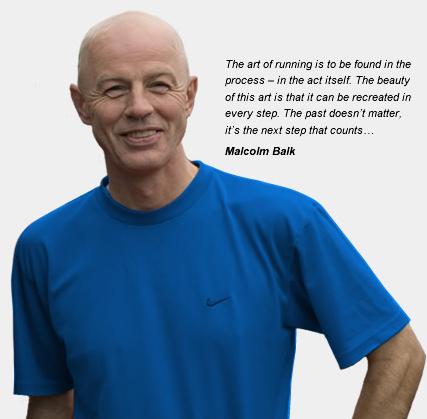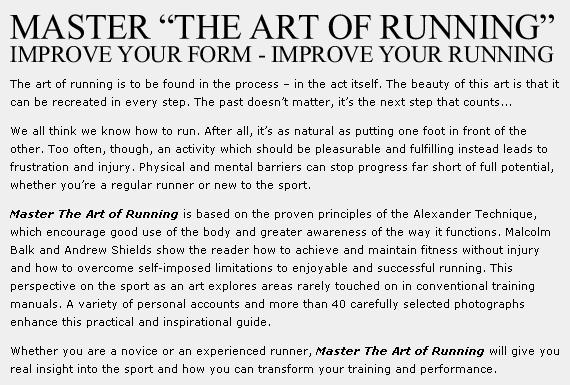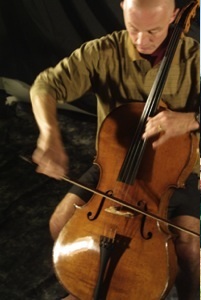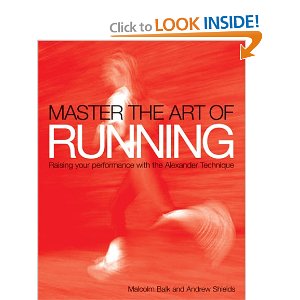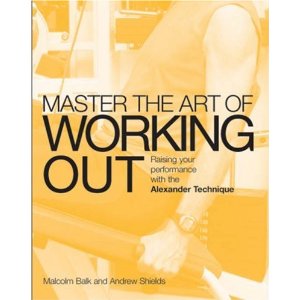Malcolm Balk wrote the books The Art Of Running and The Art Of Working Out.
I took his running workshop ten days ago in Los Angeles and got all inspired.
Luke: “How did you discover the Alexander Technique?”
Malcolm: “I had a lot of problems with tension. She suggested I might want to take some lessons.
“I’d never heard of it. It sounded a bit weird, but I trusted her and had a few lessons. It was a bit of a blur. My first teacher didn’t explain a whole lot. It was an interesting physical process. I wasn’t able to understand the link between thinking and inhibition and direction. The thought that thinking could have an influence on the quality of my movement was not on my radar screen.”
Luke: “When did Alexander Technique start to make sense to you?”
Malcolm: “In my second year of training [to be an Alexander teacher].
“Some things intellectually made sense to me [early on]. The idea of an organizing principle behind movement made sense. I wanted to understand. If I could learn to teach the Alexander Technique, it was something I could do my whole life because there were teachers in their 80s. That appealed to me. No matter what else I did in life in terms of work, Alexander would always be there for me.
“I also thought it could help me play the cello better.”
Malcolm trained for three years under Patrick MacDonald to learn to teach the Technique, graduating in 1984, a year before his friend and classmate Pedro de Alcantara.
“I found the whole [Alexander teacher training] process made me really strong. I used to get up at seven, go for a run, come back, practice the cello for half an hour, jump on my bike, cycle to school, jump on my bike, cycle to work for half an hour, work from one until ten, jump on my bike, one hour home, and repeat. I could do that and go out and drink and party on the weekend.”
“What was hard about the class was that not a lot was explained. We struggled to understand what we were being asked to do. What was inhibition? What were the steps? How were we supposed to work? Many of us went outside the class trying to find answers. I went out and had lessons for many years with Marjorie Barlow, Alexander‘s niece, who was very good at filling in the gaps.”
“Pedro and I were good friends. He helped me a lot with applying the Alexander Technique to playing the cello. He used to run with me. He improved his running a lot and I improved my cello playing.”
“I was quite close with his first wife and he with my first wife. We all used to hang out together and go for runs on Saturday morning and have pancakes with maple syrup.”
Luke: “Why do Alexander teachers go through so many spouses?”
Malcolm: “It’s all that forward and up.”
Malcolm was born in Scotland but moved to the United States at age two and then to Montreal.
Luke: “How did you come to running?”
Malcolm: “I came to running after I played ice hockey. I took up the cello. It was the middle of the running boom in the mid’70s. I started running with a good friend. Nike came out with their first shoes. Having shoes enabled us to run. I wasn’t a good runner. I was clueless. There wasn’t a lot of literature out there. I had no idea how to do it. I often had sore legs. We became marathoners.”
“I didn’t wreck anything. I hurt a lot of things. I was always getting injured. I liked running but I wasn’t enjoying it anymore. I met a coach who talked about running form. He made us sprint. And I got interested in running again.”
Luke: “How did Alexander Technique affect your running?”
Malcolm: “I had to become a conscious runner. Patrick MacDonald told me I could keep running during the training as long I didn’t tighten myself up. I gave myself directions a lot. I’d be running along and telling my neck to release and for my head to go forward and up. I stopped getting injured.”
Luke: “Is there anything you find amusing about the Alexander Technique world?”
Malcolm: “Watching Alexander Technique teachers try to dance. It’s like trying to teach a pig to sing. You’re going to fail and you’re only going to end up annoying the pig. Alexander teachers tend to have the pole up the ass syndrome and when they try to dance, they try not to move the pelvis. It’s quite a sight.”
Luke: “What are some of the biggest misconceptions that people have about running?”
Malcolm: “That it’s bad for you. That it’s going to hurt your knees. Your uterus will fall out and land on the floor. I’m not physically capable of it. Excuses are like noses, everybody has one. There’s always some reason why they can’t do it.
“The Alexander community is not that active. They don’t exercise much. They lean forward in a chair and occasionally do a monkey. If you don’t do it, it’s easy enough to demonize it, which justifies your own fears of getting outside your comfort zone.”
Luke: “Don’t most running coach say you can’t change someone’s form?”
Malcolm: “Absolutely. If you don’t have the skills of an Alexander teacher or of a really good coach, you’re probably right. Try to change any habit. Why do Alexander teachers train for 1600 hours just to get to the starting gate? It’s because habit is hard to change, especially with something as unconscious as our gait.”
“Even though I had lessons for a year before I started training [to become an Alexander teacher], when people asked me how I was going to support myself in London, an expensive city, I said, ‘I start the course in September. In November I’ll have a few students and make my money like that.’ It was a rude awakening. I didn’t take on any students until my last term. I was out to lunch. I had no clue what the training process was.”
“There were a few people in the course on trust funds, the rest of us had to work.”
“I was never a fast runner as a kid. I’m still trying to make up for that.”

